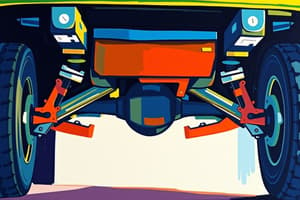Podcast
Questions and Answers
What is the primary purpose of using proper lifting techniques?
What is the primary purpose of using proper lifting techniques?
- To enhance teamwork during material handling.
- To prevent injuries and ensure safe handling of materials. (correct)
- To make the lifting process faster.
- To increase productivity in lifting tasks.
Which action should be avoided to minimize injury risk while lifting?
Which action should be avoided to minimize injury risk while lifting?
- Bending at the knees and hips.
- Maintaining a wide base of support.
- Lifting with the back muscles. (correct)
- Keeping the load close to the body.
What should be done before attempting to lift an object?
What should be done before attempting to lift an object?
- Lift the object quickly to avoid strain.
- Ask a co-worker for help without assessing the load.
- Twist the body to make lifting easier.
- Assess the load's weight, shape, and size. (correct)
What is a significant hazard associated with dropped objects?
What is a significant hazard associated with dropped objects?
Which of the following practices helps prevent dropped object incidents?
Which of the following practices helps prevent dropped object incidents?
How can equipment malfunctions that may lead to drops be reduced?
How can equipment malfunctions that may lead to drops be reduced?
Which of the following is not a recommended practice for preventing accidents in material handling?
Which of the following is not a recommended practice for preventing accidents in material handling?
What role do safety signs play in the workplace?
What role do safety signs play in the workplace?
Flashcards
Safe Lifting Technique
Safe Lifting Technique
Using proper body mechanics to lift objects to avoid back injuries.
Dropped Objects Hazard
Dropped Objects Hazard
Risk of serious injury or damage from falling objects.
Preventing Drops
Preventing Drops
Methods to stop objects from falling, like secure storage and support.
Proper Equipment Maintenance
Proper Equipment Maintenance
Signup and view all the flashcards
Good Housekeeping
Good Housekeeping
Signup and view all the flashcards
Lifting Equipment
Lifting Equipment
Signup and view all the flashcards
Assess Load Before Lifting
Assess Load Before Lifting
Signup and view all the flashcards
Communication in Teams
Communication in Teams
Signup and view all the flashcards
Study Notes
Mechanical Lifting Techniques
- Proper lifting techniques are crucial for preventing injuries and ensuring safe handling of materials.
- Maintain a wide base of support to enhance stability during lifting.
- Keep the load close to the body.
- Use leg muscles for lifting, not back muscles.
- Bend at the knees and hips, keeping the back straight.
- Avoid twisting the body while lifting.
- Use proper lifting equipment and assistance whenever possible.
- Assess the load's weight, shape, and size before attempting to lift it.
- Proper lifting technique reduces risk of back injuries. Improper methods increase the risk of severe lower back pain.
Dropped Objects
- Dropped objects pose a significant safety hazard due to impact forces and potential damage.
- Falling objects can cause severe injuries: bruises, abrasions, fractures, internal organ damage or even death.
- Dropping objects can damage equipment and property.
- Assess the potential risk and hazards associated with dropping objects.
- Use proper handling and storage procedures to avoid falls.
- Ensure adequate support for objects to be transported or stored.
- Secure loose objects to prevent their displacement and subsequent dropping during transit.
- Regularly inspect equipment for wear and tear to minimize the risk of drops.
- Be aware of the surrounding environment, considering factors like uneven surfaces or obstacles.
- Implement standardized procedures for handling and transportation of items.
Preventing Accidents
- Training on proper lifting techniques is essential for all personnel involved in material handling.
- Implementing good housekeeping practices helps prevent dropped objects by maintaining clear pathways, preventing tripping hazards, and organizing storage areas.
- Proper equipment maintenance and regular inspections can drastically reduce the chances of equipment malfunctions and subsequent drops.
- Using appropriate safety gear, such as harnesses or high visibility apparel when working at height minimizes the risk.
- Establishing clear communication protocols, especially in team work helps prevent mishaps.
- Safety signage in the work area highlighting the importance of safe lifting procedures further conveys the correct technique.
- Constant supervision and monitoring in the work area assists in early detection of unsafe practices and potential accidents.
Risk Assessment
- Risk assessments should identify potential drop hazards, evaluate the severity of impacts if they occur, and suggest appropriate control measures.
- Identifying individuals most susceptible to workplace injuries, particularly back injuries.
- Consider the weight of the object, dimensions of the area to be transported, the materials being used, and the nature of the task.
- Assess the level of supervision needed, taking into consideration the experience of the workforce and the required complexity of the task.
- Evaluate the environmental conditions that might affect lifting, including weather, terrain, and equipment stability.
- Evaluate the specific lifting equipment or devices needed to assure the safety of the activity.
Studying That Suits You
Use AI to generate personalized quizzes and flashcards to suit your learning preferences.




